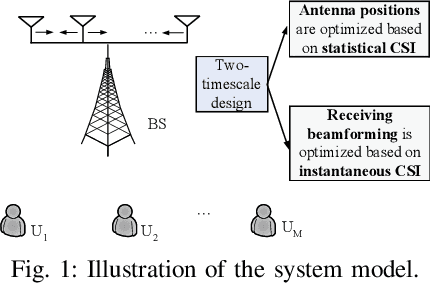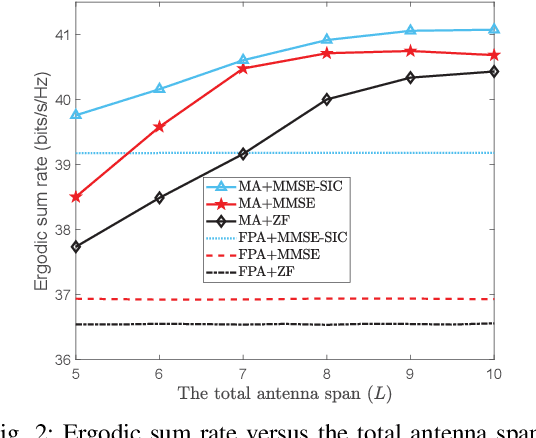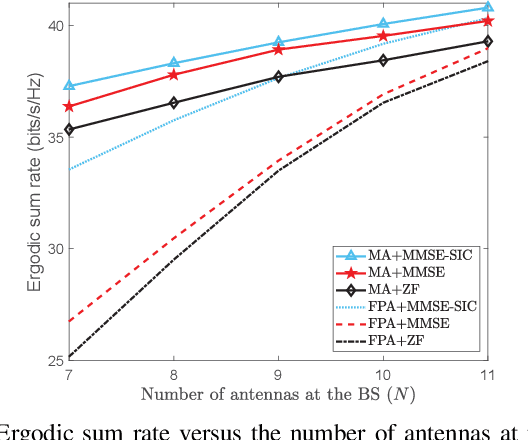Kui Xu
Two-Timescale Design for Movable Antenna Array-Enabled Multiuser Uplink Communications
Jul 25, 2024


Abstract:Movable antenna (MA) technology can flexibly reconfigure wireless channels by adjusting antenna positions in a local region, thus owing great potential for enhancing communication performance. This letter investigates MA technology enabled multiuser uplink communications over general Rician fading channels, which consist of a base station (BS) equipped with the MA array and multiple single-antenna users. Since it is practically challenging to collect all instantaneous channel state information (CSI) by traversing all possible antenna positions at the BS, we instead propose a two-timescale scheme for maximizing the ergodic sum rate. Specifically, antenna positions at the BS are first optimized using only the statistical CSI. Subsequently, the receiving beamforming at the BS (for which we consider the three typical zero-forcing (ZF), minimum mean-square error (MMSE) and MMSE with successive interference cancellation (MMSE-SIC) receivers) is designed based on the instantaneous CSI with optimized antenna positions, thus significantly reducing practical implementation complexities. The formulated problems are highly non-convex and we develop projected gradient ascent (PGA) algorithms to effectively handle them. Simulation results illustrate that compared to conventional fixed-position antenna (FPA) array, the MA array can achieve significant performance gains by reaping an additional spatial degree of freedom.
Movable-Antenna Array Enabled Multiuser Uplink: A Low-Complexity Gradient Descent for Total Transmit Power Minimization
Dec 10, 2023



Abstract:We investigate multiuser uplink communication from multiple single-antenna users to a base station (BS), which is equipped with a movable-antenna (MA) array and adopts zero-forcing receivers to decode multiple signals. We aim to optimize the MAs' positions at the BS, to minimize the total transmit power of all users subject to the minimum rate requirement. After applying transformations, we show that the problem is equivalent to minimizing the sum of each eigenvalue's reciprocal of a matrix, which is a function of all MAs' positions. Subsequently, the projected gradient descent (PGD) method is utilized to find a locally optimal solution. In particular, different from the latest related work, we exploit the eigenvalue decomposition to successfully derive a closed-form gradient for the PGD, which facilitates the practical implementation greatly. We demonstrate by simulations that via careful optimization for all MAs' positions in our proposed design, the total transmit power of all users can be decreased significantly as compared to competitive benchmarks.
Movable-Antenna Array-Enabled Wireless Communication with CoMP Reception
Nov 20, 2023

Abstract:We consider the movable antenna (MA) array-enabled wireless communication with coordinate multi-point (CoMP) reception, where multiple destinations adopt the maximal ratio combination technique to jointly decode the common message sent from the transmitter equipped with the MA array. Our goal is to maximize the effective received signal-to-noise ratio, by jointly optimizing the transmit beamforming and the positions of the MA array. Although the formulated problem is highly non-convex, we reveal that it is fundamental to maximize the principal eigenvalue of a hermite channel matrix which is a function of the positions of the MA array. The corresponding sub-problem is still non-convex, for which we develop a computationally efficient algorithm. Afterwards, the optimal transmit beamforming is determined with a closed-form solution. In addition, the theoretical performance upper bound is analyzed. Since the MA array brings an additional spatial degree of freedom by flexibly adjusting all antennas' positions, it achieves significant performance gain compared to competitive benchmarks.
Secure Wireless Communication via Movable-Antenna Array
Nov 13, 2023



Abstract:Movable antenna (MA) array is a novel technology recently developed where positions of transmit/receive antennas can be flexibly adjusted in the specified region to reconfigure the wireless channel and achieve a higher capacity. In this letter, we, for the first time, investigate the MA array-assisted physical-layer security where the confidential information is transmitted from a MA array-enabled Alice to a single-antenna Bob, in the presence of multiple single-antenna and colluding eavesdroppers. We aim to maximize the achievable secrecy rate by jointly designing the transmit beamforming and positions of all antennas at Alice subject to the transmit power budget and specified regions for positions of all transmit antennas. The resulting problem is highly non-convex, for which the projected gradient ascent (PGA) and the alternating optimization methods are utilized to obtain a high-quality suboptimal solution. Simulation results demonstrate that since the additional spatial degree of freedom (DoF) can be fully exploited, the MA array significantly enhances the secrecy rate compared to the conventional fixed-position antenna (FPA) array.
Intelligent Reflecting Surface-Aided Wireless Communication with Movable Elements
Nov 04, 2023Abstract:Intelligent reflecting surface (IRS) has been recognized as a powerful technology for boosting communication performance. To reduce manufacturing and control costs, it is preferable to consider discrete phase shifts (DPSs) for IRS, which are set by default as uniformly distributed in the range of $[ - \pi,\pi )$ in the literature. Such setting, however, cannot achieve a desirable performance over the general Rician fading where the channel phase concentrates in a narrow range with a higher probability. Motivated by this drawback, we in this paper design optimal non-uniform DPSs for IRS to achieve a desirable performance level. The fundamental challenge is the \textit{possible offset in phase distribution across different cascaded source-element-destination channels}, if adopting conventional IRS where the position of each element is fixed. Such phenomenon leads to different patterns of optimal non-uniform DPSs for each IRS element and thus causes huge manufacturing costs especially when the number of IRS elements is large. Driven by the recently emerging fluid antenna system (or movable antenna technology), we demonstrate that if the position of each IRS element can be flexibly adjusted, the above phase distribution offset can be surprisingly eliminated, leading to the same pattern of DPSs for each IRS element. Armed with this, we then determine the form of unified non-uniform DPSs based on a low-complexity iterative algorithm. Simulations show that our proposed design significantly improves the system performance compared to competitive benchmarks.
SegVoxelNet: Exploring Semantic Context and Depth-aware Features for 3D Vehicle Detection from Point Cloud
Feb 13, 2020



Abstract:3D vehicle detection based on point cloud is a challenging task in real-world applications such as autonomous driving. Despite significant progress has been made, we observe two aspects to be further improved. First, the semantic context information in LiDAR is seldom explored in previous works, which may help identify ambiguous vehicles. Second, the distribution of point cloud on vehicles varies continuously with increasing depths, which may not be well modeled by a single model. In this work, we propose a unified model SegVoxelNet to address the above two problems. A semantic context encoder is proposed to leverage the free-of-charge semantic segmentation masks in the bird's eye view. Suspicious regions could be highlighted while noisy regions are suppressed by this module. To better deal with vehicles at different depths, a novel depth-aware head is designed to explicitly model the distribution differences and each part of the depth-aware head is made to focus on its own target detection range. Extensive experiments on the KITTI dataset show that the proposed method outperforms the state-of-the-art alternatives in both accuracy and efficiency with point cloud as input only.
A^2-Net: Molecular Structure Estimation from Cryo-EM Density Volumes
Jan 06, 2019



Abstract:Constructing of molecular structural models from Cryo-Electron Microscopy (Cryo-EM) density volumes is the critical last step of structure determination by Cryo-EM technologies. Methods have evolved from manual construction by structural biologists to perform 6D translation-rotation searching, which is extremely compute-intensive. In this paper, we propose a learning-based method and formulate this problem as a vision-inspired 3D detection and pose estimation task. We develop a deep learning framework for amino acid determination in a 3D Cryo-EM density volume. We also design a sequence-guided Monte Carlo Tree Search (MCTS) to thread over the candidate amino acids to form the molecular structure. This framework achieves 91% coverage on our newly proposed dataset and takes only a few minutes for a typical structure with a thousand amino acids. Our method is hundreds of times faster and several times more accurate than existing automated solutions without any human intervention.
* 8 pages, 5 figures, 4 tables
 Add to Chrome
Add to Chrome Add to Firefox
Add to Firefox Add to Edge
Add to Edge